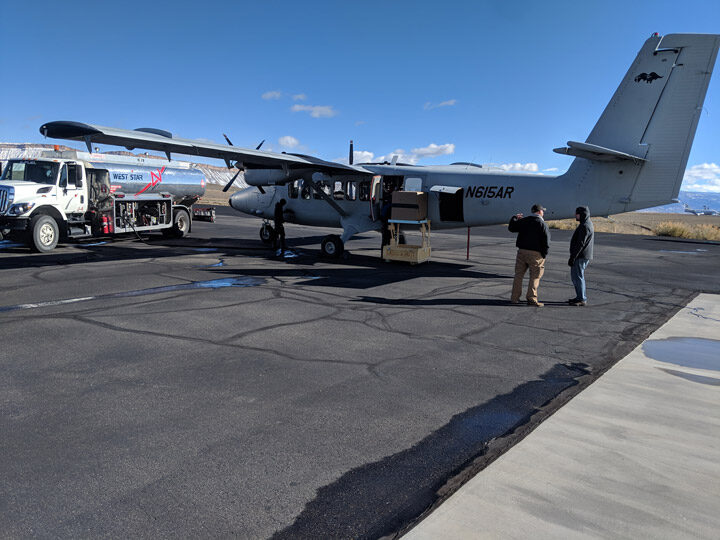Thanks to the dedicated work of the NASA Langley Airworthiness and Safety Review Board, SWESARR was cleared to fly Friday afternoon (November 30), and was able to conduct its maiden flight on Saturday December 1, 2018. The flight took place around the Grand Junction airport, and lasted just over 2 hours. During that time, the radar collected data at 1500, 2000, and 3000 meters above ground level (AGL) in various radar operation modes.

The Twin Otter aircraft is getting fuel for the SWESARR flight, while Quenton Bonds is taking radiometer calibration measurements. James Jacobson from NASA Ames is discussing the Applanix boot procedure with pilot Grant Frost.
First flight went as expected with minor issues to tackle, verifying the instrument operation, and tweaking parameters. At all times beyond 10,000 feet MSL the crew used additional O2, per NASA regulations. At any given moment, there was always a lot to do for the three qualified non-crew members (a.k.a. the scientists and engineers).

Rafael Rincon is setting up the instrument parameters, while keeping a keen eye on the signal levels coming in at all times. Chase Kielbasa, is monitoring the radiometer measurements.

Grand Junction Airport from the air. Four corner reflectors (radar calibration targets) at different sizes are installed in the field, visible in the middle of the image.
After the first flight, the team got the data off the computer and started processing the hours of data that were collected. Data analysis continued on Sunday, to take a hard look at the data quality and instrument performance. The analysis will continue when the team is back at Goddard, but all indications are positive.
The hard efforts of two team members, Rafael Rincon in the field, and Tobias Bollian at Goddard, are producing good results as the first images from SWESARR radar start to come in. The team is analyzing the images to tweak the instrument parameters to achieve best image quality.

Preliminary image by Rafael Rincon, showing X-band Co-polarization imagery. Motion compensation is not applied to this image, and effects of airplane motion can be seen as the variation in near-range distance and blurring at along-track dimension when the aircraft motion was too strong. Application of motion compensation will remove such artifacts.



